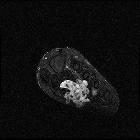phlebolith


















Phleboliths are literally "vein stones", and represent calcification within venous structures. They are particularly common in the pelvis where they may mimic ureteric calculi, and are also encountered frequently in venous malformations. There is an association with Maffucci syndrome.
Radiographic features
Phleboliths appear as focal calcifications, often with radiolucent centers (if present, a helpful sign to distinguish them from urolithiasis). This appearance is attributed to calcification peripherally within the vessel and is frequently seen on abdominal radiographs (66% of phleboliths ). It can also be seen on CT provided thin sections are obtained (at 5 mm thick slices radiolucent centers will be inapparent in 99% of phleboliths ).
Differential diagnosis
Two signs are helpful in distinguishing a ureteric calculus from a phlebolith:
Siehe auch:
- Phlebolithen im Becken
- prävesikaler Harnleiterstein
- Harnleiterstein
- Phlebolithen in Ovarialvene
- Maffucci-Syndrom
- Servelle-Martorell syndrome
- soft-tissue rim sign
- Kometenschweif-Zeichen (Phlebolithen)
und weiter:
- verkalkte Milzläsionen
- Urolithiasis
- Nierensteine
- Weichteilhämangiom
- subkutane Verkalkungen
- Gefäßverkalkungen
- Hämangiom der Nebenniere
- focal splenic calcifications
- abdominelle und pelvine Verkalkungen
- rim-sign (of ureteric calculi)
- rim sign in chronic hydronephrosis
- Kometenschweif-Zeichen (CT Lunge)
- retroperitoneal haemangioma
- soft tissue rim sign
- multiple haemangiomas of the head and neck
- low flow venous malformation
- Phlebektasie
- Phlebolithen in Varikozele
- intraabdominelle Verkalkungen

 Assoziationen und Differentialdiagnosen zu Phlebolithen:
Assoziationen und Differentialdiagnosen zu Phlebolithen:





